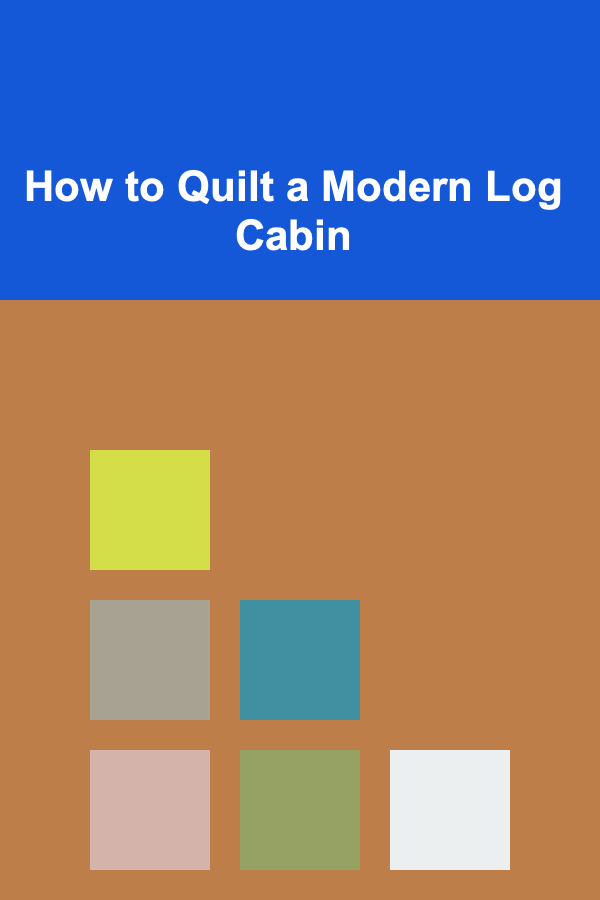
How to Quilt a Modern Log Cabin
ebook include PDF & Audio bundle (Micro Guide)
$12.99$10.99
Limited Time Offer! Order within the next:

Quilting is a time-honored craft that combines art and functionality, creating beautiful, often meaningful pieces. One of the most iconic quilt patterns is the Log Cabin design, which has evolved over the years. While traditional Log Cabin quilts are deeply rooted in history, modern interpretations of the pattern are gaining popularity for their clean lines, minimalist approach, and ability to blend with contemporary décor. In this guide, we'll explore how to quilt a modern Log Cabin, step by step, from choosing fabrics to piecing and quilting the final project.
Understanding the Log Cabin Quilt
The Log Cabin quilt is one of the oldest and most recognized quilt patterns, dating back to the 19th century. Traditionally, it consists of strips of fabric sewn around a central square (called the "heart" of the cabin). These strips are added in a specific order, alternating light and dark fabrics, to create a visually striking effect.
In modern interpretations, the Log Cabin design can be simplified or updated with contemporary fabrics, colors, and layout techniques. The beauty of a modern Log Cabin quilt is that it allows for creativity and individuality while still respecting the traditional structure.
Materials and Tools
Before diving into the construction of your modern Log Cabin quilt, it's important to gather the necessary materials and tools. Here's a list to get you started:
Materials:
-
Fabric: For a modern Log Cabin quilt, you'll need fabric in a variety of colors and patterns. Choose fabrics that resonate with your aesthetic. You'll need:
- One central square fabric (a neutral color like white, black, or gray works well).
- Fabric for the "logs" or strips, in varying widths and colors. You can opt for solids, geometric prints, or even floral patterns for a modern look.
- A backing fabric (this will be the fabric on the back of your quilt).
- Binding fabric (for finishing the edges of the quilt).
-
Batting: This is the soft, fluffy material that will be sandwiched between the quilt top and backing. Choose a batting with the right thickness for your desired quilt feel.
Tools:
- Rotary cutter: This tool is essential for cutting fabric strips with precision.
- Cutting mat: Protect your work surface and ensure accurate cuts.
- Ruler: A quilting ruler helps measure and cut fabric strips uniformly.
- Quilt piecing machine: While hand-piecing is an option, using a sewing machine will save you time and give you cleaner seams.
- Thread: Choose a high-quality cotton thread in a neutral color.
- Iron and ironing board: Pressing seams as you go is essential for a polished finish.
- Quilting pins or clips: These will help hold your pieces together as you sew.
Choosing Your Fabric Colors and Style
The first step in quilting a modern Log Cabin is deciding on the fabric and color scheme. Modern Log Cabin quilts often embrace bold, contrasting colors, geometric prints, and clean lines. However, the options are endless. Here are a few ideas to inspire you:
a. Neutral with Bold Accents
For a minimalist approach, start with a neutral central square (such as gray or white) and surround it with bold-colored logs in varying widths. The contrast between the neutral center and vibrant strips creates a modern aesthetic.
b. Monochrome with Textured Fabrics
Another modern approach is using a single color in various shades for the logs, with a textured fabric for the central square. This creates a sophisticated and cohesive look, with subtle variations in tone adding interest.
c. Geometric Prints and Solids
Mixing geometric or abstract prints with solid colors is a hallmark of modern quilting. Use solid strips for the logs and a geometric print for the central square or vice versa. The sharp contrast between the two elements creates a striking, contemporary feel.
d. Modern Florals
Incorporating modern florals into the traditional Log Cabin pattern adds a fresh twist. Use large-scale floral prints for the logs or central square and balance them with solid colors to prevent the quilt from becoming too busy.
Cutting the Fabric
Once you've decided on your fabric, the next step is cutting it into the necessary pieces. For a modern Log Cabin quilt, you'll need to cut strips of fabric to create the "logs." The width of these strips can vary depending on the look you're going for. For a more streamlined and modern design, consider using narrow strips (about 1.5--2 inches). For a more traditional appearance, wider strips (2.5--3 inches) work well.
a. Cutting the Central Square
Start by cutting your central square, which will form the heart of the cabin. The size of the square will depend on the overall size of your quilt. A typical starting size for a central square might be 4.5 inches by 4.5 inches.
b. Cutting the Logs
For each Log Cabin block, you'll need a selection of fabric strips in various lengths. Typically, you'll need strips that are at least 12 inches long to ensure they are long enough for piecing. If your quilt is large, you may want to cut longer strips, but 12 inches is a good starting point. Make sure to vary the colors and widths to create visual interest and modern appeal.
Piecing the Quilt
Now that your fabric is cut, it's time to start piecing the quilt. The traditional Log Cabin pattern follows a specific order for adding the logs, but a modern interpretation often allows for more flexibility. You can choose to add the logs in a more randomized or planned order depending on your design.
a. Start with the Central Square
Place your central square on your work surface, and then begin sewing the first strip of fabric onto one side of the square. This strip should be sewn right sides together. Use a quarter-inch seam allowance for all your piecing.
b. Add Logs Around the Square
After the first strip is attached, press the seam, and then add the next strip on the opposite side. Continue adding strips of fabric in a clockwise or counterclockwise direction, alternating between light and dark fabrics or playing with color blocks for a modern, geometric effect.
c. Press and Trim the Edges
As you add each log, press the seam flat with an iron to reduce bulk and keep the fabric neat. Once you've added enough logs around the central square, use your rotary cutter and ruler to trim the edges of the block to ensure all sides are even.
d. Create Multiple Blocks
Repeat this process to create multiple blocks for the quilt top. The number of blocks you need will depend on the size of the quilt you're making. Most Log Cabin quilts are made up of multiple blocks sewn together into rows, so plan accordingly.
Assembling the Quilt Top
Once all of your Log Cabin blocks are complete, it's time to assemble the quilt top. Lay out the blocks in the desired configuration, ensuring that the colors and patterns align in a way that is visually appealing. For a modern look, try to arrange the blocks with symmetry or use an asymmetrical layout for added interest.
Once you're satisfied with the arrangement, sew the blocks together in rows. Press the seams as you go to keep the quilt top flat and smooth.
Adding the Backing and Batting
Now that the quilt top is complete, it's time to assemble the quilt sandwich, which consists of the quilt top, batting, and backing fabric.
a. Choose a Backing Fabric
For modern quilts, backing fabric is often chosen to complement the front of the quilt. It can be a simple solid color, a geometric print, or even a large-scale design that contrasts with the front.
b. Layer the Quilt
Lay the backing fabric on a flat surface, then place the batting on top, followed by the quilt top. Smooth out any wrinkles and ensure that the layers are aligned. Pin or baste the layers together to keep them in place while quilting.
Quilting the Layers
Now comes the quilting itself, which adds texture and holds the layers together. For a modern Log Cabin quilt, you can choose from a variety of quilting styles. Straight-line quilting is a popular choice for modern quilts, as it complements the clean lines of the Log Cabin pattern. You can quilt in parallel lines, diagonals, or even create geometric shapes within the blocks.
Use a walking foot on your sewing machine to help guide the layers through evenly and prevent shifting. If you prefer hand quilting, this can be a great way to add a personal, tactile element to your quilt.
Adding the Binding
Once the quilt is quilted, it's time to finish the edges with binding. Binding is typically a strip of fabric that is folded over the quilt's raw edges and sewn down by hand or machine. Choose a binding fabric that complements your quilt design---either match the quilt top for a seamless look or contrast for added drama.
To attach the binding, sew the strips together end-to-end, then press and fold the fabric before stitching it to the quilt's edges. This final step ensures that your quilt has a neat, professional finish.
Final Thoughts
Quilting a modern Log Cabin quilt is a rewarding and creative process that allows you to explore new color combinations and design possibilities. By embracing modern fabrics, layouts, and quilting techniques, you can transform a traditional pattern into a fresh and stylish piece that reflects your personality and creativity. Whether you're making a small wall hanging or a full-sized quilt, the Log Cabin design provides endless opportunities for expression and innovation.
Reading More From Our Other Websites
- [Tie-Dyeing Tip 101] From Plain to Prismatic: Creative Tie-Dye Patterns for Towels
- [Beachcombing Tip 101] Best Beachcombing Locations in the UK
- [Home Pet Care 101] How to Bathe a Cat: A Stress-Free Guide for Cat Owners
- [Home Family Activity 101] How to Master the Perfect Backyard Bonfire with S'mores for All Ages and Skill Levels
- [Digital Decluttering Tip 101] Inbox Overload? Proven Strategies to Tame Email and Reclaim Your Time
- [Home Space Saving 101] How to Choose the Right Laundry Space Saver Storage Rack
- [Home Holiday Decoration 101] How to Design Holiday Party Decorations That Will Impress Your Guests
- [Personal Care Tips 101] How to Whiten Your Teeth Without Irritating Your Mouth
- [Organization Tip 101] How to Keep Your HVAC System Running Smoothly Year-Round
- [Home Space Saving 101] How to Organize Your Small Kitchen Drawers

How to Teach Kids About Car Organization from an Early Age
Read More
How to Use Color Coding in Your Garden for Visual Appeal
Read More
How to Use DIY Projects to Upgrade Your Home's Interior
Read More
How to Understand Why People Believe in Conspiracy Theories
Read More
How To Foster Critical Thinking in Young Minds
Read More
Using Technology for Wildlife Protection
Read MoreOther Products

How to Teach Kids About Car Organization from an Early Age
Read More
How to Use Color Coding in Your Garden for Visual Appeal
Read More
How to Use DIY Projects to Upgrade Your Home's Interior
Read More
How to Understand Why People Believe in Conspiracy Theories
Read More
How To Foster Critical Thinking in Young Minds
Read More